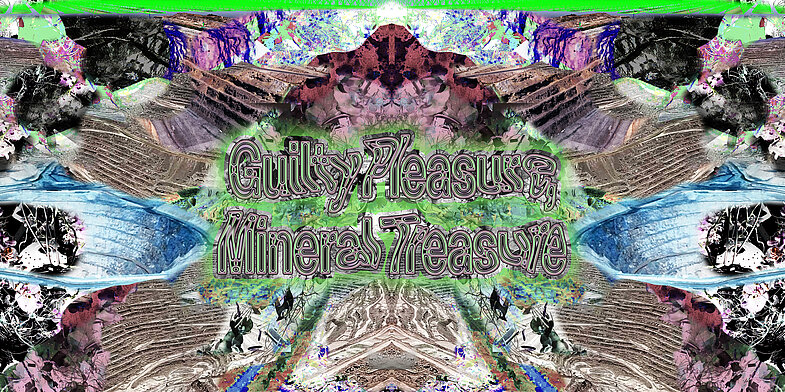
The environment is in a constant state of change, and human activity is constantly pushing it forward and leaving its traces on the landscape. Many regions of the world are characterised by the extraction of raw materials and industrialisation; in the Ruhr area, mining is the history of the last century. Now the mines are closed and the exploitation of raw materials continues in places outside Europe in order to ensure supply, consumption and technological progress in the West. Our own relationship to consumption and its effects is thus further abstracted from its origins. Natural resources are becoming increasingly scarce and inequitably distributed, CO2 levels in the atmosphere are rising, climate change is making regions uninhabitable as a result of continued extraction, and there is a growing sense of powerlessness.
In response to our alienation from our environment and from all life that is more than human, the artists in the exhibition design practices and mind games that invite us to take action and approach the world in the Anthropocene from a new perspective. They use VR, video, installation and interactive games. Despite their diverse aesthetics, the installations have one thing in common: they playfully question our current position in the world and our relationship with nature.
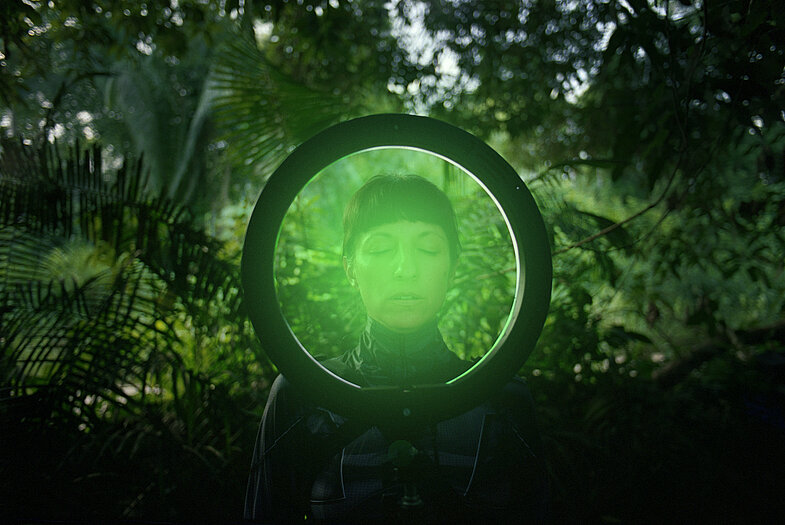
Matrix Vegetal combines experimental ethnobotany, South American quantum thinking, dream fiction and organic connection technologies to broaden perception and better understand the workings of the plant and spiritual universe. From botanical science fiction, the video proposes a restoration of communication between the human and the more-than-human, representing visions, teachings and routes delivered by the plant universe and offering a poetic perspective of contemporary existence, intricately intertwined with the earth.
The video installation emerges as an artistic interpretation of the experience of Patricia Domínguez, who was apprenticed to Amador Aniceto, a healer living in Madre de Dios, Peru. Amador has been condecorated by the plants as "General Physician of the Flora and Fauna of the Universe" for his sacred, multiple and mystical vision of the plant universe.
Under his guidance, the artist activated an intimate process of connection with living knowledge. To do so, she set out to achieve a temporary detachment from the digital matrix, activating instead an alliance with the vegetal matrix. In this way, she established a link with the language that goes beyond the human, connecting with the planetary memory.
Patricia Domínguez was born in Santiago, Chile in 1984, and lives and works in Puchuncaví, Chile. Through a wide variety of media, Domínguez draws upon myths, symbols, rituals and healing practices, combining artistic imagination with experimental research on ethnobotany. Domínguez works with watercolours, ceramics, sculptural assemblages and video installations to create shrine-like imagery derived from a visual vocabulary that spans from plant life, mass market goods, corporate wellness schemes and the digital world.
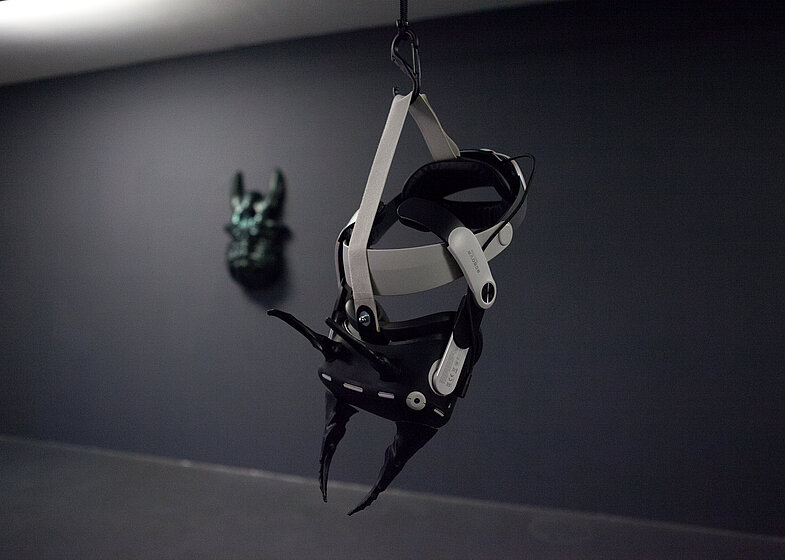
The narrative starting point of the mixed-reality installation Night Companions is the behavior of dung beetles, which orient themselves using the polarized light of the moon or – on moonless nights – by the Milky Way, if not disturbed by urban light pollution or communication satellites. How do non-human actors like dung beetles deal with these new bodies in the sky? Are they inexplicable events? Confusing elements? Totems? Deities?
In the installation, comprised of sculptures resembling the carapaces of dung beetles, exhibition visitors engage in an extended reality experience using VR goggles modified with beetle antennas. Seated on a sphere resembling the dung balls these beetles transport, the visitors navigate through the landscape. In the forest clearing, they must locate constellations to help them find feces to add to their ball. Using a VR tracker, they decide between polarized natural light and light reflections generated by satellites in order to move through a virtual narrative by means of eye-tracking. Mistakes in identifying the constellations activate the front-facing cameras of the VR goggles, revealing the actual space around the visitors, while a communications satellite engages them with machine-like expressions. For Night Companions,' Nieves de la Fuente Gutiérrez links real spatial and virtual experiences of human and non-human perspectives, in a speculative attempt to address disturbances in animal navigation systems and a call for empathy.
Nieves de la Fuente, born in Madrid, Spain, in 1988, received her Bachelor of Fine Arts from the Universidad Complutense de Madrid. From 2013 to 2016, she studied at the Academy of Media Arts Cologne, where she completed her postgraduate studies. In 2018, she worked as an artistic research assistant at the Academy of Media Arts Cologne and later at Burg Giebichenstein University of Art and Design Halle.
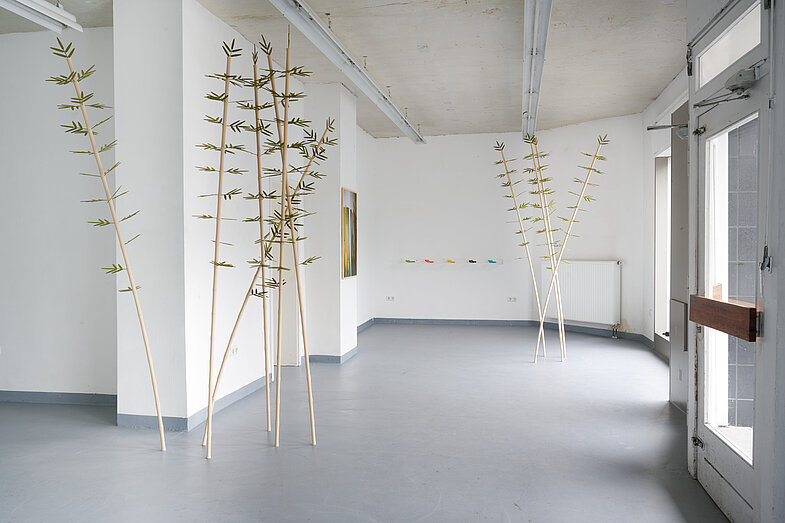
It may only be a brief moment of illusion, but in this case it seems as if real bamboo is growing in the exhibition space. Filigree and slightly tilted, the individual bamboo canes stand on their own, looking as if they have emerged from a simple VR environment with a low-poly aesthetic. With their segmented stems, uniform size and rhizomatic distribution in the exhibition space, their appearance follows the growth principles of bamboo. However, they are not a simplified, mimetic reproduction of nature. The bamboos claim a piece of actual naturalness, as up to 30% bamboo fibre is added to the filament from which they are 3D printed. According to the manufacturer, this is to achieve a natural feel and authentic wood aesthetics. These artificial bamboo plants are part of an (artistic) tradition of human attempts to imitate nature using technology. Bamboo is particularly suited to this kind of appropriation because, despite its myriad growth forms, there are typical and simplified ideal images of the plant. This can be seen, for example, in the fashion for "faux bamboo" furniture at the end of the 19th century, which was designed to look like it was made of bamboo, even though it was made of other types of wood. However, this false bamboo blocks this kind of appropriation and moves in a state of in-between of technical imitation and authentic materiality.
Wiebke Meischner lives and works in Essen and studied Photography at the Folkwang University of Arts until 2022.
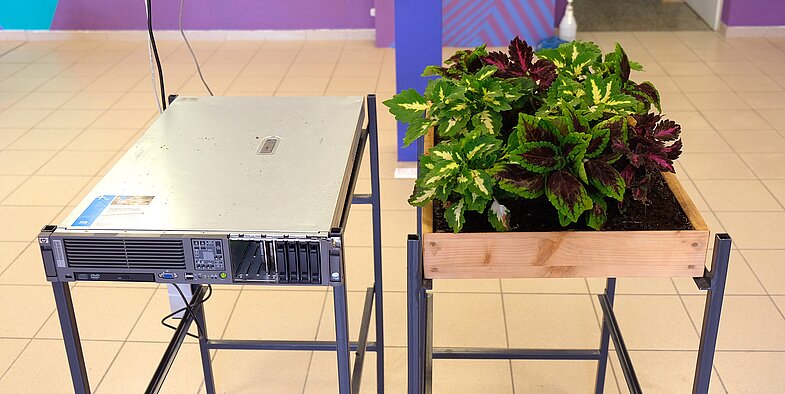
The garden beds in the gallery bind the CO2 emissions produced by the running server. However, emissions and sequestration happen at radically different times. The single website hosted on the server, https://tendergarden.io, calculates and logs in real time the carbon footprint between the garden and the server.
The CO2 economy that has emerged in recent decades seeks to invent a methodology to connect economic production with its biochemical impact on the environment.
The work stages such conversions between data, energy, carbon, and biochemical labor, thereby raising questions about current CO2 calculation models. In the work, the ecological footprint of the digital economy materializes. More broadly, tendergarden.io questions the efficacy of applying logic of financial products in relation to CO2 policy.
Marina Resende Santos is an artist and researcher based in Berlin. In her work, she addresses issues of agency, technology and ecology in urban space through interventions in public space and research-based projects. She holds a degree in comparative literature from the University of Chicago and is currently pursuing a master's degree at the weißensee kunsthochschule berlin. She was editor of Lumpen Magazine and is co-founder of the project space Make-up in Berlin.
Chicago-based artist, educator, and writer Graham Livingston delves into the complex intersections between the digital and physical realms. Currently teaching new media art at the University of Illinois at Chicago, his art practice seeks to understand how our perceptions of objects, environments, and people are shaped by their digital representations.
Through his transmedial practice, which encompasses objects, installations, and performances, Livingston creates multifaceted perspectives on his subjects, spanning spatial, physical, and digital platforms. His recent work has investigated themes such as computational periscopy, urban screen ecologies, and the geography of the internet. Each project underscores the pervasive and evolving nature of digitality in our contemporary world.
www.marinaresendesantos.com/home.html
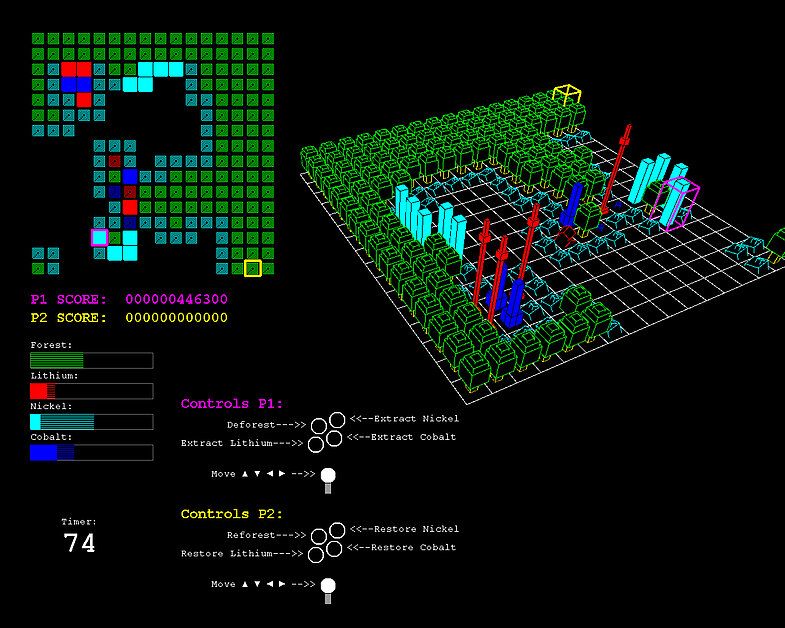
Camilo Sandoval is a multidisciplinary artist with a focus on experimental computing. Based on an animistic perspective, he advocates for a man-machine relationship of coexistence and symbiosis. Among many subsequent topics, he likes to deal with the ethics and morals of machine identity/spirit, transhumanism, man-machine cooperation and education and anything related to enouncing the future of artificial systems.
Honour Providence, Honour Good Men is an arcade game for two players. It deals with our relationship with Nature: resources exploitation vs. land preservation. Both players have 2min to compete on real time on the same map: player one has to deforest and find mineral veins of cobalt, nickel and lithium (all essential to today´s electronic industry) and build mines to extract them; player two has to dismantle those mines and then reforest on top of the land where the trees were torn down. The simple gaming mechanic makes for a competitive experience that, through role-playing, invites the player to reflect about greed, unlimited growth capitalism, balance, extractivism, resources value… The console is built with recycled materials: an oil barrel, reused computer screens, reclaimed wood. The arrangement of the screens on top of one another makes it necessary to enter into a power-impotence situation not only virtually but also physically. It becomes a metaphor for colonial power structures.
17 August - 6 October 2024
Press tour / Curator's tour
Friday, 16 August, 5.30 pm
Opening
Friday, 16 August, 7 pm
Artists:
Patricia Dominguez
Nieves de la Fuente
Wiebke Meischner
Marina Resende Santos & Graham Livingston
Camilo Sandoval
Hafenspaziergang
Saturday, 31 August, 2 - 7 pm
DEW21-Museumsnacht
Saturday, 21 September, 4 - 10 pm
7 pm Curator's tour
8 pm, Concert / Performance: WIFI Gold (Live)
Film screening (with Camera Paradiso e.V.)
Sunday, 6 October, 7 pm
Taming the Garden (Die Zähmung der Bäume)
Documentary film by Salomé Jashi (90 min., 2021, OmU)
Curators:
Jana Kerima Stolzer & Lex Rütten
Images works: © the artists
Kindly supported by:
Kulturbüro Dortmund